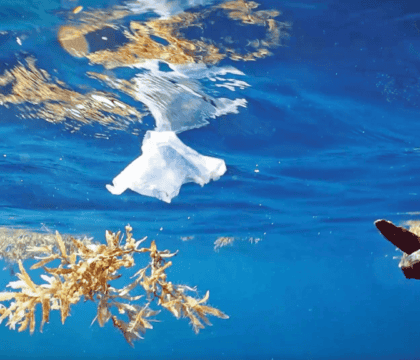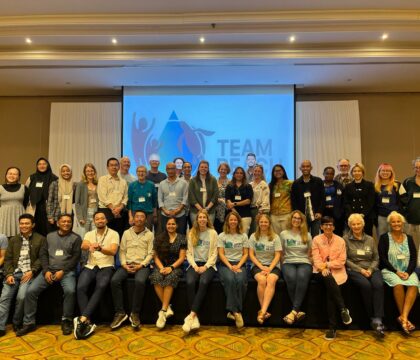October 18, 2023 • Blue Habits Tips, Resources
Getting to watch a sea turtle lay her eggs is one of the most incredible wildlife experiences you can have. But seeing this phenomenon requires plenty of planning and preparation! Most likely your turtle experience involves a guide taking you out on the beach, and they may have mentioned that you should bring a red flashlight or red-light headlamp that is turtle safe. But, not all lights are created equal, which begs the question: What’s the best turtle safe flashlight?
As a sea turtle biologist who has spent many nights searching for nesting sea turtles on pitch-black beaches, I can confirm that having a reliable red-light headlamp is crucial for ensuring you get the most out of the experience.
Before we get in to everything you need to know when choosing a turtle safe red-light headlamp, why do you need to use red light around sea turtles? Well, sea turtles are highly sensitive to white light at night. White light can impair their vision and cause them to become disoriented on their return to the ocean, and it can even deter them from nesting altogether. On the other hand, red lights emit a narrow portion of the visible light spectrum, and research has shown that they are much less likely to disturb, deter, or disorient sea turtles. So, red-light-capable lights should always be used when participating in nighttime sea turtle research or a sea turtle tour, as they will allow you to see but will not interfere with the turtles’ natural behaviors.
Features to Consider in a Turtle Safe Flashlight
There are a few key features to consider when choosing the best flashlight for watching sea turtles. To begin, headlamps are generally recommended over handheld flashlights because they allow you to keep your hands free, making it easier to record data or help take measurements of the turtles, as is possible on some sea turtle volunteer programs. Even if you are not participating in research, having your hands free can help you keep your balance and stay safe while walking in the dark, which is never a bad thing! So, in our recommendations we are focusing specifically on turtle safe headlamps.
When choosing a red-light headlamp, there are several factors to consider. These include:
- Battery Life: A long-lasting battery is crucial, especially if you’ll be out on the beach searching for sea turtles throughout the night. There’s nothing worse than being on a beach at midnight and the batteries dying on you! Having a headlamp with a battery life of 8 hours or more is ideal.
- Durability: Sea turtles often nest in tropical places known for unexpected rainfall, which, in addition to the fact that the salt air and sand are hard on electronics, means that you’ll need a durable, waterproof headlamp that can withstand the elements.
- Comfort: Depending on what kind of sea turtle experience you’ll be having, you might be wearing your headlamp for long periods, so it’s essential to choose one that is lightweight and comfortable.
- Intensity: You’ll want the red light in your headlamp to be strong enough to sufficiently illuminate your surroundings without being so bright as to risk disturbing the turtles.
6 Best Turtle Safe Red-Light Headlamps

Oceanic Society volunteers use sea turtle safe red-light headlamps while collecting data on leatherback turtles in Trinidad. © Ashleigh Bandimere
Black Diamond Spot Headlamp
Max white light output: 400 lumens | Battery type: 3 AAA batteries | Weight: 76.5 g | Durability features: Waterproof | Price: $49.95 at REI
This lightweight headlamp has all of the basic features you need for a sea turtle tour or for working with sea turtles and is a great option for the price. One of its best features is that you don’t have to cycle through the red light to activate the red light, which makes things simpler on the beach!
Petzl Actik Core Headlamp
Max white light output: 450 lumens | Battery type: 3 AAA batteries or PETZL CORE rechargeable battery (separate accessory) | Weight: 98g | Durability features: weather resistant | Price: $54.95 at PETZL
PETZL is known for making reliable headlamps, and this one is no exception. It will serve you well in any weather conditions that you might encounter on the beach.
BioLite Headlamp 325
Max white light output: 325 lumens | Battery type: USB rechargeable | Weight: 51 g | Durability features: Weather resistant | Price: $49.95 at REI
The slim profile of this headlamp makes it comfortable to wear for long periods. It also has a dimmable red light, so you can customize the intensity to your needs on the beach. The fact that the light is manufactured with sustainable features is an added bonus!
Princeton Tec Vizz Headlamp
Max white light output: 550 lumens | Battery type: 3 AAA batteries | Weight: 92 g | Durability features: Waterproof | Price: $49.99 at Princeton Tec
Marketed as waterproof and with 2 red “ultrabright” LEDs, this headlamp stands out. Factor in the lifetime warranty that Princeton Tec offers, and this headlamp makes it to the top of the recommendation list.
Fenix HM70R Rechargeable Headlamp
Max white light output: 1600 lumens | Battery type: rechargeable USB-C | Weight: 206 g | Durability features: Waterproof and impact resistant | Price: $99.95 at Fenix
While this is one of the most expensive headlamps on this list, its red light output is one of the strongest, making it a strong contender for the best headlamp option. It’s also resistant to dirt, impacts, and water, so it should stand up well to the beach conditions. The one downside is its weight and relative bulkiness compared to the other headlamps mentioned on this list.
Energizer Pro360 Headlamp
Max white light output: 360 lumens | Battery type: Three AAA batteries | Weight: 105 g | Durability features: Water resistant | Price: $24.99 at Amazon
This is a great low-cost headlamp option and, while they aren’t the most powerful or durable red-light headlamps, they’re sufficient for anyone going on a night tour or a short stint with sea turtles.
Learn More and Help Save Sea Turtles
When choosing a turtle safe flashlight, keep in mind the factors we discussed and you’re sure to find a headlamp that’s best suited for you and safe to use around nesting sea turtles! With the right equipment and a commitment to conservation, we can help protect sea turtles and their natural habitats. For more information about sea turtles and sea turtle conservation, check out the following resources:




